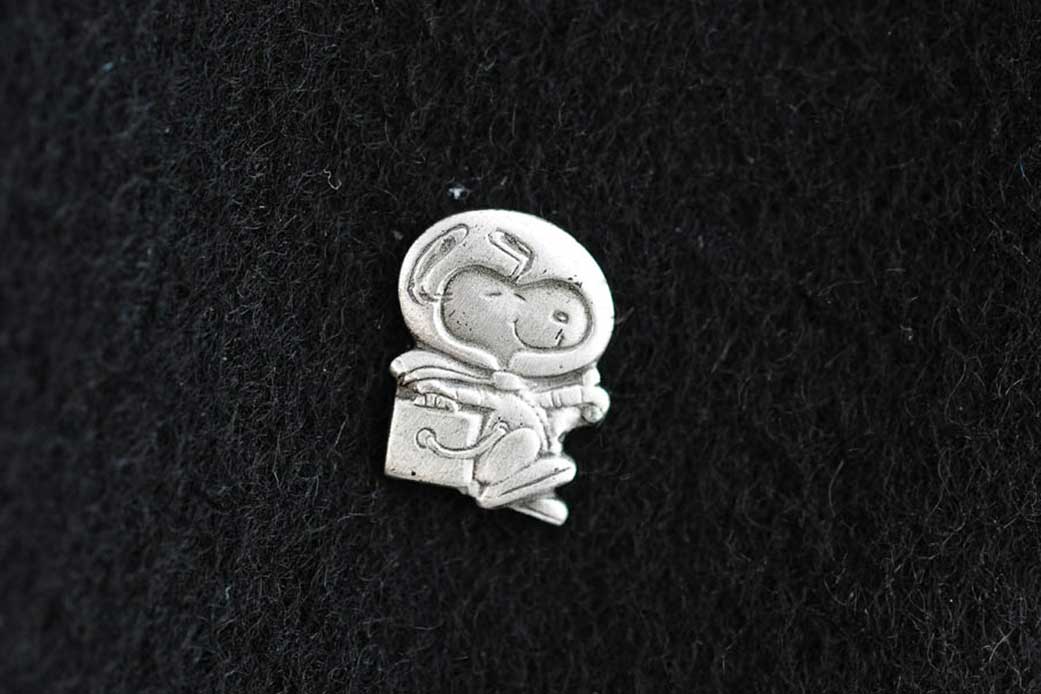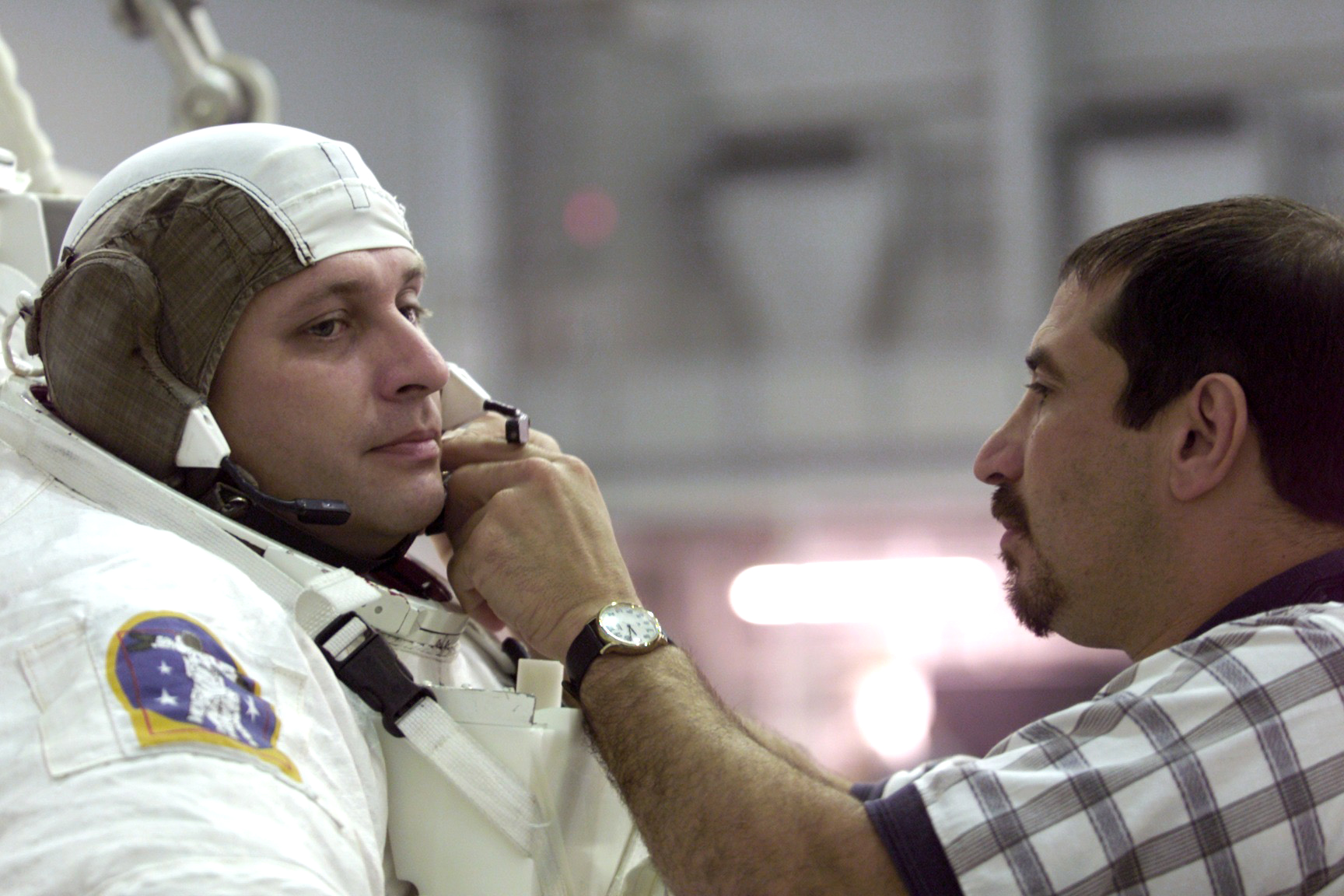Patek Phillippe watch, Hermes tie, Cartier aviator sunglasses. All are aspirational items for those who want to dress to impress. However, the lapel pin that Dr. Louis Carfagno (’91, ’01) earned the right to wear carries greater status in the world of aerospace.
NASA astronaut Piers Sellers presented Carfagno, a spacesuit engineer, with the Silver Snoopy. Only one percent of NASA employees or contractors earn this honor each year. The small sterling pin flew with Mission Specialist Sellers on STS-112. Space Shuttle Atlantis flew this 11-day mission to the International Space Station in 2002.

The Silver Snoopy award dates back to 1968 and acknowledges outstanding performance that guarantees flight safety and mission success.
His 2003 recognition from the Space Flight Awareness program at NASA is just one highlight in a career that includes piloting spy planes, fitting astronauts for spacesuits, serving as a technical advisor to blockbusters and now, teaching fellow Eagles in the College of Business at Embry-Worldwide as an adjunct assistant professor.
An Indirect Flight Path
Carfagno didn’t like school much. He gave college a try, but soon followed his father’s advice to join the service. The U.S. Air Force was the obvious choice for a kid with happy memories of trips to the Philadelphia airport to watch the airplanes land and takeoff. The movie “Top Gun” also made a big impression. In the six-month delay following his enlistment, he earned his commercial pilot’s license.
Unlike Maverick, he did not end up in the cockpit of an F-14 Tomcat. However, the Air Force more than delivered on his need for speed, putting him in an SR-71, which travels three times the speed of sound. The Lockheed SR-71 “Blackbird” is a long-range, high-altitude, Mach 3+ plane designed for aerial reconnaissance. Carfagno’s career as a military pilot took him to Cypress, RAF Mildenhall in England and Okinawa, Japan. He became an Embry-Riddle Worldwide student because he could study no matter where his assignments took him.
“In those days, there was no Internet. We used cassettes, read the book and took proctored exams,” he remembers. He completed his Bachelor of Science in Professional Aeronautics in three years.
After leaving the Air Force, he returned to Philadelphia and juggled two jobs until a friend helped him find a job with NASA. He began his Master of Aeronautical Science in Human Factors in Aviation Systems and Aviation Aerospace Management with Worldwide in 1998 and finished in 2001. He would later add a Doctor of Management in Organizational Leadership from the University of Phoenix-Arizona.
Helping Astronauts Suit Up
Building and fine-tuning a spacesuit and training an astronaut to function efficiently in the suit requires patience and precision. The secret to a good fit? “Having an astronaut who cooperates with you,” he says. Fitting the gloves alone can take hours and teaching astronauts to use them is a process.
They start with a mold nicknamed for astronaut Scott Parazynski and begin customizing.
— Dr. Louis Carfagno (’91, ’01)
“No matter what you do — taking out the garbage, building spacesuits or flying airplanes — do your very best.”
“You have to get nominal contact between finger crotches and fingertips,” Carfagno explains. “Each finger of the gloves has adjustment cords that are adjusted incrementally. We put astronauts in a “glove box” with a bit of the vacuum where they test out the fit.”
“Gloves can make or break any mission.”
Nothing about a NASA spacesuit is one-size-fits-all or off the rack. In fact, a spacesuit is a collection of modular pieces: a primary life support subsystem (PLSS), the hard upper torso (HUT), arm assemblies and a lower torso assembly of pants and boots. Everything must be adjusted to the individual’s measurements. The suits also require an allowance at the waist because in orbit, your spine elongates two to three inches.
The space-ready suit is unforgiving. Astronauts cannot gain weight because a faulty fit can cost them the opportunity to fly. It was Carfagno’s painstaking work on the spacesuits for the STS-112 mission that brought him his Silver Snoopy.
Going Hollywood
Knowing your way around a spacesuit can bring unusual career opportunities. While still with NASA, Carfagno was a technical director for the films “Space Cowboys” and “Armageddon.” He even enjoyed a blink-or-you’ll-miss-it moment on screen with “Space Cowboys” star Clint Eastwood, thanks to direction from co-star Donald Sutherland on where to appear in an over-the-shoulder shot. He set up shots for that film at the NASA Neutral Buoyancy Laboratory in Houston.
Another celebrity encounter brought him back to his early inspiration to fly fast planes. In 2002, he got to put Tom Cruise in a spacesuit. The actor visited NASA while narrating an IMAX documentary on the Space Station.
In 2010, Carfagno began teaching at Worldwide. Why? “I love Embry-Riddle,” he says.
He currently teaches a course on air cargo management and lives what he teaches, also serving as a corporate training and safety professional with AccuFleet International, based in Houston.
His advice to students is not about winning awards, but focuses on stepping up, consistently, especially when it comes to safety.
“Integrity is everything. Sometimes you have to deliver bad news that you don’t want to deliver, but you have to do it anyway,” he says.
“No matter what you do — taking out the garbage, building spacesuits or flying airplanes — do your very best. If you compromise, then you start making mistakes. Keep standards high and people will come up to those standards every time.”
